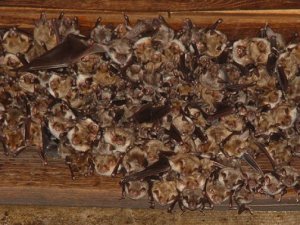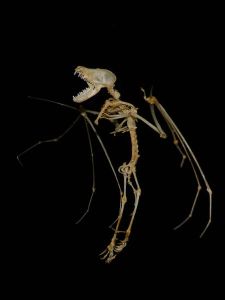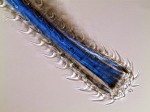Parasitologists commonly observe species in which one sex is more heavily parasitized than the other. For example, territorial male impalas carry a much higher tick load than bachelor or female impalas (paper by Mooring and colleagues found here). Territorial males spend less time grooming to remove ticks and instead spend their time watching for intruding males and wandering females.
Most of the explanations I’ve read for why one sex is more heavily burdened by parasites have focused on how host behavior, physiology and immune status influences their infection status. Few studies have examined if males or females have higher parasite loads because parasites are actively choosing one sex over another.
I was excited yesterday to come across this paper which examined whether or not parasitic mites are capable of preferentially infesting one sex. These researchers had previously observed that female bats from the genus Myotis are often infested with more mites than are males and so they decided to examine whether part of this pattern could be explained by the parasites “preferring” females.
 Mites can not survive very long on their own and require a host for food and energy. It’s in the mite’s best interest to try to stay in areas of high bat density. This way they have plenty of other hosts when they reproduce and their offspring need to find a host of their own. It’s also a good idea to have other alternatives nearby in case the bat that the mite is currently living on falls ill and the mite needs to abandon ship.
Mites can not survive very long on their own and require a host for food and energy. It’s in the mite’s best interest to try to stay in areas of high bat density. This way they have plenty of other hosts when they reproduce and their offspring need to find a host of their own. It’s also a good idea to have other alternatives nearby in case the bat that the mite is currently living on falls ill and the mite needs to abandon ship.
If you’re like me, then when you imagine what bats you envision a cave wall with bats crammed in there nose to nose. The bats that roost in these large groups are females with their young. The males on the other hand, are loners. Instead of roosting with the group, they find a place to hunker down on their own. This means that, given a choice, mites should prefer to infest females who will surround themselves with other tasty bats over males encounter other bats far less frequently.
 Researchers decided to test whether or not mites were capable of preferentially infecting females given a choice between both sexes. They placed a male and a female bat into an enclosed arena where their movements were limited and released a set number of mites into the enclosure. After keeping track of the mites’ choices, the researchers released the bats into an outdoor arena. Ten days later, the bats were recaptured and mite survival was quantified.
Researchers decided to test whether or not mites were capable of preferentially infecting females given a choice between both sexes. They placed a male and a female bat into an enclosed arena where their movements were limited and released a set number of mites into the enclosure. After keeping track of the mites’ choices, the researchers released the bats into an outdoor arena. Ten days later, the bats were recaptured and mite survival was quantified.
I know lots of people who don’t seem to know what’s good for them, but the mites seem to have it all figured out. The mites choose adult females significantly more often than they choose adult males AND their survival on female bats was much higher than on males.
The exact mechanism by which the mites differentiate between the sexes is unknown, but it’s likely that they’re using hormonal cues.
The more I learn about parasites the more amazed I am at how good they are at keeping themselves alive. This study showed that they’re capable of making good decisions when picking a host and I’ve discussed in a previous post how parasites are able to alter the behavior of hosts that they’ve successfully infected. I wouldn’t be surprised to find that the decisions made by parasites are driving differences in parasite loads between the sexes in lots of other species as well.










